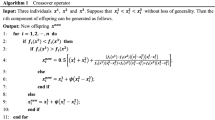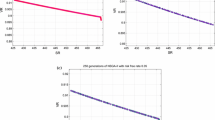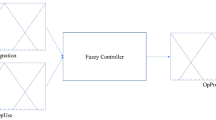Abstract
The uncertainty associated with the financial domain in modern portfolio selection problems can be overcome by using fuzzy set theory. The portfolio is modified in this paper using the possibility theory instead of the probability theory by formulating the risk return as fuzzy numbers, and we also take into account the V-shaped transaction costs. The possibilistic semi-absolute deviation portfolio selection technique is used to develop a portfolio selection framework by considering the investor demands and stock characteristics. The higher computational complexity associated with the possibilistic mean semi-absolute deviation portfolio model is reduced using the hybris salp swarm-based Coot algorithm (SCOOT). The main aim of the hybrid SCOOT algorithm is to reduce the risk and increase the expected return. The salp swarm algorithm is integrated with the coot algorithm to enhance the global search capability. The performance of the proposed approach is evaluated with the extensive experiments conducted on the Bombay Stock Exchange dataset. The results obtained show that the proposed methodology offers better performance when considering the transaction costs, and its performance is very high when compared to the conventional metaheuristic techniques.






Similar content being viewed by others
References
Chen, W., Wang, Y., Mehlawat, M.K.: A hybrid FA–SA algorithm for fuzzy portfolio selection with transaction costs. Ann. Oper. Res. 269(1), 129–147 (2018)
Edirisinghe, C., Zhou, W.: Portfolio optimization using rank correlation. In: Wang, J. (ed.) Encyclopedia of Business Analytics and Optimization, pp. 1866–1879. IGI Global, Hershey (2014)
Guo, S., Gu, J.W., Ching, W.K.: Adaptive online portfolio selection with transaction costs. Eur. J. Oper. Res. (2021). https://doi.org/10.1016/j.ejor.2021.03.023
Škrinjarić, T.: Fuzzy logic in portfolio selection: selected applications. In: Christiansen, B., Škrinjarić, T. (eds.) Handbook of Research on Applied AI for International Business and Marketing Applications, pp. 173–190. IGI Global, Hershey (2021)
Tang, O., Musa, S.N.: Identifying risk issues and research advancements in supply chain risk management. Int. J. Prod. Econ. 133(1), 25–34 (2011)
Chen, L.H., Huang, L.: Portfolio optimization of equity mutual funds with fuzzy return rates and risks. Expert Syst. Appl. 36(2), 3720–3727 (2009)
Sundararaj, V.: Optimised denoising scheme via opposition-based self-adaptive learning PSO algorithm for wavelet-based ECG signal noise reduction. Int. J. Biomed. Eng. Technol. 31(4), 325 (2019)
Sundararaj, V., Anoop, V., Dixit, P., Arjaria, A., Chourasia, U., Bhambri, P., Rejeesh, M.R., Sundararaj, R.: CCGPA-MPPT: Cauchy preferential crossover-based global pollination algorithm for MPPT in photovoltaic system. Prog. Photovolt. Res. Appl. 28(11), 1128–1145 (2020)
Ravikumar, S., Kavitha, D.: CNN-OHGS: CNN-oppositional-based Henry gas solubility optimization model for autonomous vehicle control system. J. Field Robot. (2021). https://doi.org/10.1002/rob.22020
Ravikumar, S., Kavitha, D.: IoT based home monitoring system with secure data storage by Keccak–Chaotic sequence in cloud server. J. Ambient Intell. Hum. Comput. (2020). https://doi.org/10.1007/s12652-020-02424-x
Rejeesh, M.R.: Interest point based face recognition using adaptive neuro fuzzy inference system. Multimed. Tools Appl. 78(16), 22691–22710 (2019)
Kavitha, D., Ravikumar, S.: IOT and context-aware learning-based optimal neural network model for real-time health monitoring. Trans. Emerging. Telecommun. Technol. 32(1), e4132 (2021)
Gowthul Alam, M.M., Baulkani, S.: Local and global characteristics-based kernel hybridization to increase optimal support vector machine performance for stock market prediction. Knowl. Inf. Syst. 60(2), 971–1000 (2019)
Gowthul Alam, M.M., Baulkani, S.: Reformulated query-based document retrieval using optimised kernel fuzzy clustering algorithm. Int. J. Bus. Intell. Data Min. 12(3), 299 (2017)
Nisha, S., Madheswari, A.N.: Secured authentication for internet voting in corporate companies to prevent phishing attacks. Int. J. Emerg. Technol. Comput. Sci. Electron. 22(1), 45–49 (2016)
Sundararaj, V., Muthukumar, S., Kumar, R.S.: An optimal cluster formation based energy efficient dynamic scheduling hybrid MAC protocol for heavy traffic load in wireless sensor networks. Comput. Secur. 77, 277–288 (2018)
Vinu, S.: An efficient threshold prediction scheme for wavelet based ECG signal noise reduction using variable step size firefly algorithm. Int. J. Intell. Eng. Syst. 9(3), 117–126 (2016)
Marling, H., Emanuelsson, S.: The Markowitz portfolio theory. November 25, 2012
Francis, J.C., Kim, D.: Modern Portfolio Theory: Foundations, Analysis, and New Developments, p. 795. Wiley, Hoboken (2013)
Ali, M.R., Ma, W.X.: Detection of new multi-wave solutions in an unbounded domain. Mod. Phys. Lett. 33(34), 1950425 (2019)
Baleanu, D., Sadat, R., Ali, M.R.: The method of lines for solution of the carbon nanotubes engine oil nanofluid over an unsteady rotating disk. Eur. Phys. J. Plus 135(10), 1–13 (2020)
Ali, M.R., Hadhoud, A.R., Ma, W.X.: Evolutionary numerical approach for solving nonlinear singular periodic boundary value problems. J. Intell. Fuzzy Syst. (2020). https://doi.org/10.3233/JIFS-201045
Ali, M.R., Hadhoud, A.R.: Hybrid orthonormal Bernstein and block-pulse functions wavelet scheme for solving the 2D Bratu problem. Results Phys. 12, 525–530 (2019)
Ma, W.X., Ali, M.R., Sadat, R.: Analytical solutions for nonlinear dispersive physical model. Complexity (2020). https://doi.org/10.1155/2020/3714832
Ali, M.R., Sadat, R.: Lie symmetry analysis, new group invariant for the (3 + 1)-dimensional and variable coefficients for liquids with gas bubbles models. Chin. J. Phys. 71, 539–547 (2021)
Ali, M.R., Sadat, R.: Construction of lump and optical solitons solutions for (3 + 1) model for the propagation of nonlinear dispersive waves in inhomogeneous media. Opt. Quan. Electron. 53(5), 1–13 (2021)
Sabir, Z., Ali, M.R., Raja, M.A.Z., Shoaib, M., Núñez, R.A.S., Sadat, R.: Computational intelligence approach using Levenberg–Marquardt backpropagation neural networks to solve the fourth-order nonlinear system of Emden–Fowler model. Eng. Comput. (2021). https://doi.org/10.1007/s00366-021-01427-2
Ayub, A., Sabir, Z., Altamirano, G.C., Sadat, R., Ali, M.R.: Characteristics of melting heat transport of blood with time-dependent cross-nanofluid model using Keller–Box and BVP4C method. Eng. Comput. (2021). https://doi.org/10.1007/s00366-021-01406-7
Chen, L., Gao, R., Bian, Y., Di, H.: Elliptic entropy of uncertain random variables with application to portfolio selection. Soft Comput. 25(3), 1925–1939 (2021)
Guo, S., Ching, W.K.: High-order Markov-switching portfolio selection with capital gain tax. Expert Syst. Appl. 165, 113915 (2021)
Moghadam, A., M.R., Mansouri, T., Sheykhizadeh, M.: Markowitz-based cardinality constrained portfolio selection using Asexual Reproduction Optimization (ARO). arXiv Preprint. https://arxiv.org/abs/2101.03312 (2021)
Yaman, I., Dalkılıç, T.E.: A hybrid approach to cardinality constraint portfolio selection problem based on nonlinear neural network and genetic algorithm. Expert Syst. Appl. 169, 114517 (2021)
Mohammed, H.J.: The optimal project selection in portfolio management using fuzzy multi-criteria decision-making methodology. J. Sustain. Finan. Invest. (2021). https://doi.org/10.1080/20430795.2021.1886551
Lampariello, L., Neumann, C., Ricci, J.M., Sagratella, S., Stein, O.: Equilibrium selection for multi-portfolio optimization. Eur. J. Oper. Res. (2021). https://doi.org/10.1016/j.frl.2021.102019
Joo, Y.C., Park, S.Y.: Optimal portfolio selection using a simple double-shrinkage selection rule. Finan. Res. Lett. 43, 102019 (2021)
Amin, G.R., Hajjami, M.: Improving DEA cross-efficiency optimization in portfolio selection. Expert Syst. Appl. 168, 114280 (2021)
Akbaş, S., Dalkiliç, T.E.: A hybrid algorithm for portfolio selection: an application on the Dow Jones Index (DJI). J. Comput. Appl. Math. 398, 113678 (2021)
Zolfaghari, S., Mousavi, S.M.: A novel mathematical programming model for multi-mode project portfolio selection and scheduling with flexible resources and due dates under interval-valued fuzzy random uncertainty. Expert Syst. Appl. 182, 115207 (2021)
Tavana, M., Khosrojerdi, G., Mina, H., Rahman, A.: A hybrid mathematical programming model for optimal project portfolio selection using fuzzy inference system and analytic hierarchy process. Eval. Progam Plan. 77, 101703 (2019)
Zhang, Y., Liu, W., Yang, X.: An automatic trading system for fuzzy portfolio optimization problem with sell orders. Expert Syst. Appl. 187, 115822 (2022)
Bai, Z., Liu, H., Wong, W.K.: On the Markowitz mean–variance analysis of self-financing portfolios. Risk Decis. Anal. 1(1), 35–42 (2009)
Steinbach, M.C.: Markowitz revisited: mean-variance models in financial portfolio analysis. SIAM Rev. 43(1), 31–85 (2001)
Yue, W., Wang, Y., Peng, Z.: A multi-objective evolutionary algorithm for fuzzy mean-variance-entropy portfolio models with transaction cost and liquidity. J. Comput. 29(4), 39–56 (2018)
Wang, S., Zhu, S.: On fuzzy portfolio selection problems. Fuzzy Optim. Decis. Mak. 1(4), 361–377 (2002)
Konno, H., Yamazaki, H.: Mean-absolute deviation portfolio optimization model and its applications to Tokyo stock market. Manag. Sci. 37(5), 519–531 (1991)
Yue, W., Wang, Y., Xuan, H.: Fuzzy multi-objective portfolio model based on semi-variance–semi-absolute deviation risk measures. Soft Comput. 23(17), 8159–8179 (2019)
Naruei, I., Keynia, F.: A new optimization method based on coot bird natural life model. Expert Syst. Appl. 183, 115352 (2021)
Çelik, E., Öztürk, N., Arya, Y.: Advancement of the search process of salp swarm algorithm for global optimization problems. Expert Syst. Appl. 182, 115292 (2021)
Sefiane, S., Benbouziane, M.: Portfolio selection using genetic algorithm. J. Appl. Finance Banking 2(4), 143–154 (2012)
Golmakani, H.R., Fazel, M.: Constrained portfolio selection using particle swarm optimization. Expert Syst. Appl. 38(7), 8327–8335 (2011)
Khan, A.Q., Ikram, S., Mehtab, M.: Testing weak form market efficiency of Indian capital market: a case of national stock exchange (NSE) and Bombay stock exchange (BSE). Afr. J. Mark. Manag. 3(6), 115–127 (2011)
Author information
Authors and Affiliations
Corresponding author
Rights and permissions
About this article
Cite this article
Pahade, J.K., Jha, M. A Hybrid Fuzzy-SCOOT Algorithm to Optimize Possibilistic Mean Semi-absolute Deviation Model for Optimal Portfolio Selection. Int. J. Fuzzy Syst. 24, 1958–1973 (2022). https://doi.org/10.1007/s40815-022-01251-w
Received:
Revised:
Accepted:
Published:
Issue Date:
DOI: https://doi.org/10.1007/s40815-022-01251-w




